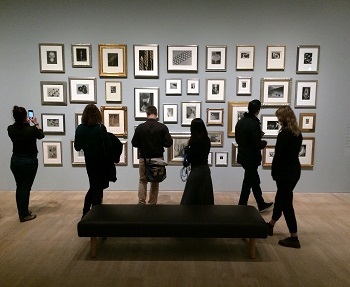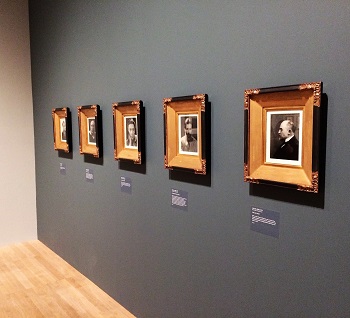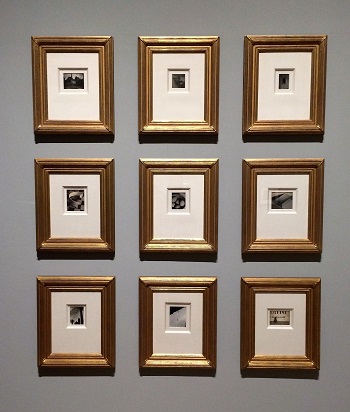
The Radical Eye: Elton John's own collection in public for the first time
The first loan exhibition in Tate Modern’s new Switch House put one of the world’s most acclaimed collection of modernist photography on public display for the first time. Almost inevitably, Jonathan Ives reports.

The Radical Eye: Elton John's own collection in public for the first time
The Radical Eye is an extraordinary exhibition. First, it explores and celebrates a period during which photography came of age, moving out of the shadow of painting and traditional portraiture to become a new form of expression, a new art form that would quickly become ubiquitous. Second, it represents a departure for Tate, which by its own admission had largely overlooked photography until recently. This exhibition has allowed Tate to acknowledge the importance of photography as a modern art form and establish Tate’s interest in and commitment to photography as part of its future. Third, and perhaps the most extraordinary aspect of The Radical Eye, is that all the works on display are taken from a single private collection. To be able to bring together works of such quality and importance is remarkable; to be able to lift them from the walls of a single collector is simply staggering.
In its full title the exhibition acknowledges the collector from the outset – “Modernist photography from the Sir Elton John Collection” – but this is more than a rock star’s vanity project. Covering a period from 1920 to 1950, the exhibition includes the most celebrated names from photography’s most celebrated age. More than 60 artists are represented, including Bernice Abbott, André Kertész, Man Ray, Alexandr Radchenko and Edward Steichen, all of whom are recognised as seminal figures in the development of the technique and vision that established photography as art.
Among the 200 or so works on display are some of these artists’, and their peers’, greatest works. Together they demonstrate an art form coming to life. Here are the artistic formats familiar for millennia –still lifes, portraits, nudes – but now they are explored and reimagined via a radically new medium. Having initially used the emergent photographic technology to reproduce and mimic these traditional forms, artists were by the 1920s using these new tools to explore and test the limits of what might be possible with a newly portable camera and a new vision of a rapidly changing world. Unseen perspectives, such as the use of “worm’s eye” and “bird’s eye” views of Rodchenko, Moholy-Nagy and Bourke-White, and new techniques, such as distortion, double exposure, solarisation and montage, whether in the camera or in the darkroom, established photography as the visual bellwether of the modernist avant garde.
The Radical Eye brings together so many of the artists and images that came to define the era and the art form. There are 25 works by Man Ray alone, including Glass Tears, Noir et Blanche and Rayograph; Kertész’s Underwater Swimmer; Edward Weston’s nudes; Ilse Bing’s Dancer, Willem van Loon, Paris; Dorothea Lange’s Migrant Mother; multiple works by Irving Penn. Many of the portraits of the stars of the modernist age gathered here have become the defining images of the subjects and the creators. Pablo Picasso, Salvador Dali, Igor Stravinsky, Henri Matisse, Georgia O’Keeffe, Noël Coward, Duke Ellington and Joe Louis are here in poses that have become part of popular culture.
While the images of The Radical Eye are recognisable, definitive, emblematic, they are also remarkable for their quality. All of the works in the exhibition are vintage prints made by the artist within five years of the image being made. Some are among the very first images made from the negative; the tiny image of Underwater Swimmer on display here is taken from Kertész’s orginal contact sheet. These are not only the best images of modernist photography but the very best prints available, many with extraordinary provenance. Dorothea Lange’s haunting 1936 image of a child of the Depression displayed here bears the legend “The damage is already done, Shacktown, Elm Grove, Oklahoma” in the artist’s handwriting on the back of the print as a note rather than as the definitive title it became.
For all this artistic grandeur, it is hard to deny the fascination of the short film within the exhibition that features Elton John explaining how he discovered this passion for photography and how the collection grew. It provides an insight to the mind of the collector and the lengths to which an obsession can drive them, particularly if they happen to have the means to fund it.
Walking round his Atlanta apartment where this collection is kept, Elton explains that when he was shown some fashion photographs by David Fahey, who runs a gallery in New York, he saw photography as an art form for the first time. That was 1990 when he had recently sold his extensive art collection in its entirety “bar four paintings” and was newly freed from years of addictions and excess. He recalls that he bought 12 images from Fahey “on the spot” and, given that that he is “obsessive by nature”, the collection began to grow from there. By 1993 he was paying a then world-record price for a photograph for Man Ray’s Glass Tears.
Dressed in a pristine black Adidas tracksuit, a style one might term “immaculate casual”, he leads the camera through the rooms, pointing out some of his favourite images. He is clearly at home; this just happens to be a home in which he is surrounded by some of the world’s most treasured photographic images displayed in extravagantly ornate frames. Every possible space, including the doors, is hung with exceptional works of art. The apartment grew with the collection and now measures some 18,000 square feet. “I didn’t need the space,” he explains. “I needed the space to put the collection on the wall.”
He wanders into the bedroom and, while perched on a leopard-skin chair in front of a bedside dressing table covered in glass ornaments and family snapshots, he points out more images on the wall.
“There you have six Elton John portraits by Irving Penn,” he says and, in the relaxed manner of someone who has spent all of his adult life in front of cameras of all kinds, he explains how they were taken: with Penn and Elton John talking about photography and Penn’s life while Penn’s camera moved slightly and slowly, creating a distorted image of Elton as he sat in the position of artist’s model. The result was a set of six photographs that are clearly of Elton John but with a lurid, disturbing flow of the subject’s features across the image.
“I’m not your normal type of person and it kind of gets the eccentricity of my life,” he says. “I kind of look like an insane Alan Bennett.” He pauses and the quiet sense of wonder in his voice lingers. “But I love these photographs so much. I had absolutely no idea how they were going to turn out but when I saw the result I was absolutely ecstatic.”
Even though they hang on the wall of his own bedroom and he sees them every day he happens to be in Atlanta, it seems that he is still in awe of the fact that Irving Penn has taken his picture and they are there in front of him. This, we begin to suspect, is a really committed collector.
“I love living with my collection,” he says. “I sleep in my bed above Noir et Blanche, which I think is pretty cool. To be able to share it with other people is the most important thing. It’s a huge honour.”
Introducing the exhibition to the press, Frances Morris, director of Tate Modern, was pleased to be able to say that this exhibition – the first loan exhibition in Tate Modern’s new Switch House – marks the beginning of a long-term relationship between Tate and the Sir Elton John Collection, including arrangements for the bequest of a number of works.
Meanwhile, The Radical Eye provides a remarkable insight to the development and establishment of photography as the world’s dominant art form, along with a fascinating insight to the mind of collector. Even if the entry fee is pretty hefty, that we are able to see it in London rather than Atlanta feels like a privilege.
Jonathan Ives is the editor of the Leisure Review.
The Radical Eye: Modernist photography from the Sir Elton John Collection is at Tate Modern until 7 May 2017. Details are available via www.tate.org.uk
The Leisure Review, March 2017
© Copyright of all material on this site is retained by The Leisure Review or the individual contributors where stated. Contact The Leisure Review for details.
![]() Download a pdf version of this article for printing
Download a pdf version of this article for printing
 On the wall: the elaborate mounts and frames are unusual for photography but service to emphasise the importance of the images.
On the wall: the elaborate mounts and frames are unusual for photography but service to emphasise the importance of the images.

Golden: the exhibition offers the best prints of the best images, some the very first prints made by the artist from the negative.